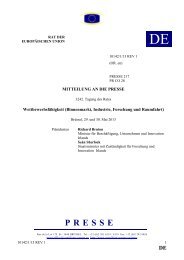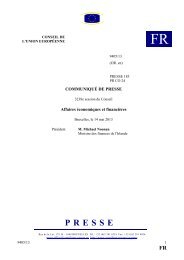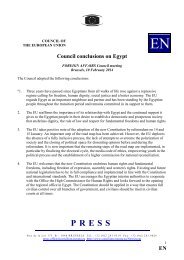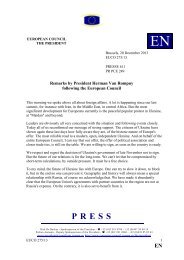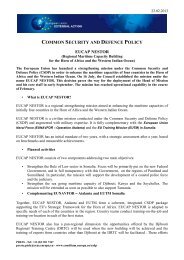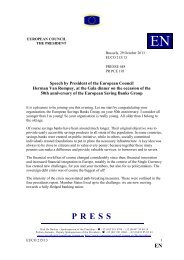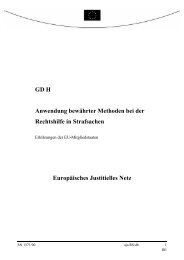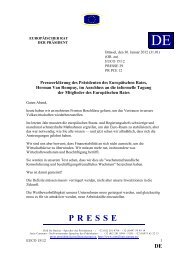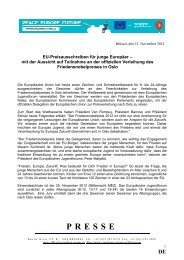You also want an ePaper? Increase the reach of your titles
YUMPU automatically turns print PDFs into web optimized ePapers that Google loves.
<strong>EUTM</strong> SOMALIA<br />
A European success story…
Contents<br />
Foreword by Mission Commander, <strong>EUTM</strong> <strong>Somalia</strong><br />
Helping <strong>Somalia</strong> to its feet<br />
Colonel Michael Beary talks about the mission, which aims to help<br />
provide security and a cohesive military to assist <strong>Somalia</strong>’s recovery<br />
The Ugandan People’s Defence Force<br />
Uganda – a country overview<br />
Facts and figures about The Pearl of Africa<br />
<strong>Somalia</strong> – a country torn apart<br />
An assessment of decades of conflict in the horn of Africa<br />
<strong>EUTM</strong> <strong>Somalia</strong> picture gallery<br />
Bihanga Training Camp<br />
An overview of the development of the <strong>EUTM</strong> <strong>Somalia</strong> training<br />
facility in the western Ugandan district of Ibanda<br />
You’re in the Army now!<br />
An in-depth look at the core business of the mission – a library of<br />
<strong>EUTM</strong> <strong>Somalia</strong> military training modules<br />
<strong>EUTM</strong> <strong>Somalia</strong> training outputs – Mandates 1 and 2<br />
A Somali perspective<br />
An interview with a Somali Company Commander, Captain Nur Ali Egal<br />
AMISOM<br />
An overview of the African Union mission in <strong>Somalia</strong><br />
VoxPops – the voices of our <strong>EUTM</strong> <strong>Somalia</strong> troops<br />
A truly European blend<br />
A look at the mix of European nations committed to <strong>EUTM</strong> <strong>Somalia</strong><br />
1<br />
Page 2<br />
Page 3<br />
Page 7<br />
Page 8<br />
Page 10<br />
Page 12<br />
Page 14<br />
Page 15<br />
Page 18<br />
Page 19<br />
Page 21<br />
Page 22<br />
Page 24<br />
The European Union’s Common Security and Defence Policy (CSDP) enables the Union to develop its<br />
civilian and military capacities for crisis management and conflict prevention at international level and to conduct<br />
operations in this area, thus helping to maintain peace and international security, in accordance with the United<br />
Nations Charter.<br />
More information and background documents on <strong>EUTM</strong> <strong>Somalia</strong> are available on:<br />
http://www.consilium.europa.eu/eeas/security-defence/eu-operations/eu-somalia-training-mission
2<br />
Foreword by Mission Commander,<br />
<strong>EUTM</strong> <strong>Somalia</strong><br />
Colonel Michael Beary<br />
<strong>Somalia</strong> continues to progress on a path toward peace and stability with the International Union<br />
supporting tentative political advances. Many challenges remain and the latter part of 2012 with<br />
the expected progression of the governmental system from a transitional body to a more long term,<br />
sustainable democratic model represents a major milestone.<br />
The European Union remains committed to assisting <strong>Somalia</strong> through many avenues but support to the<br />
security sector by assisting with the development of a new military instrument in the form of the NSF<br />
remains a fundamental part of the EU strategy to rebuild this torn country. The European Union Training<br />
Mission for <strong>Somalia</strong> concludes its second mandate during December 2012 and will have trained over<br />
3000 soldiers, NCOs and Officers who will assist in the extension of the Somali government remit to areas<br />
outside Mogadishu.<br />
The success of the mission has demonstrated not only the synergy that the military organisations of<br />
EU member states can achieve together but also the potential of international partnership in crisis<br />
management. The United Nations, the United States, the African Union, the European Union and Uganda<br />
(the host nation for the mission) have acted in unison to help rebuild the Somali Army, each playing a<br />
defined role and each facilitating fully the inputs of their partners.<br />
I believe it would be wrong to suggest that a solution is close at hand but incremental and careful<br />
redevelopment of this military instrument, improving conditions, military infrastructure, equipment and<br />
sustainment, with regular salary payment will provide the Somali Government with the means to establish<br />
a safe and secure environment for all Somali citizens. The future looks a little brighter now for <strong>Somalia</strong><br />
than at any point during the last twenty years of instability.<br />
Colonel Ricardo González Elul (Spain)<br />
Mission Commander - Mandate 1<br />
Colonel Michael Beary (Ireland)<br />
Mission Commander - Mandate 2
EUROPEAN UNION TRAINING MISSION – SOMALIA<br />
HELPING SOMALIA TO ITS FEET<br />
<strong>Somalia</strong> is moving incrementally toward a more stable environment. Major challenges remain, not<br />
least of which is the ever present threat of clan-based Warlords seeking to reassert their power and<br />
influence. Other challenges include the threat of a sustained asymmetrical campaign mounted by<br />
the extreme Islamist Al Shaabab (AS), the daily evidence of which is seen on our TV screens. Famine and<br />
piracy are also major destabilising concerns with many separate agendas regarding control of relief aid and<br />
ransom demands which can derail the fragile recovery at any point. The Transitional Federal Government<br />
(TFG) is seeking to extend its remit throughout the country, supported by the UN, US and the EU. The<br />
African Union (AU) in particular provides direct support through the AMISOM peacekeeping force. This<br />
force, led by Ugandan Lieutenant General Andrew Gutti, is fighting hard and suffering causalities in<br />
attempts to defeat AS. An ambitious three year National Security and Stabilisation Plan has now been<br />
completed to take <strong>Somalia</strong> toward stable governance following two decades of brutal conflict.<br />
The European Union<br />
In advance of a more stable environment, the institutional framework must be strengthened. The EU,<br />
while already a major contributor of finance to the region, identified the National Security Force (the approx<br />
10,000 strong Somali Army) as one<br />
body in need of urgent restructuring<br />
support. An EU Council decision<br />
on 31st March 2010 launched<br />
<strong>EUTM</strong> <strong>Somalia</strong> under UNSCR 1872<br />
to provide training support to the<br />
Somali Army. The Ugandan Army<br />
(UPDF) had an existing unilateral<br />
arrangement for providing basic<br />
training at Bihanga and the EU<br />
joined this effort, in partnership<br />
with Uganda.<br />
The Bihanga Training Camp (BTC)<br />
facility is extremely isolated, lying<br />
almost six hours by road to the west<br />
of Kampala. The logistic challenge<br />
is therefore immense and major<br />
infrastructural work was required<br />
to develop the camp to acceptable<br />
European standards, particularly in<br />
New trainee soldiers develop their skills<br />
terms of living accommodation and medical facilities. It now enjoys both a Role 1 and Role 2 hospital<br />
capability as well as an air strip to facilitate casualty evacuation. The education level of the Somali<br />
trainees is very low with up to 80% of an intake being illiterate, which impacts greatly on the speed of<br />
training delivery. An additional challenge is overcoming the deep-rooted Somali clan system to produce<br />
units with a mix of clans, even though the dominant clan from the Mogadishu urban area, the Hawiye,<br />
has been strongly represented to date. Training was initially focused on infantry techniques at recruit<br />
and junior leader level, but later extended to full Company level. The Somali army is bereft of a working<br />
Command and Control (C2) system and this had to be developed from scratch in Bihanga. The challenge<br />
remains to achieve well-structured units, clan balanced and adequately staffed by trained NCOs, Platoon<br />
Commanders, Company Staffs and Company Commanders. Additionally great emphasis is placed on<br />
training the Somalis to train themselves and to increase awareness of mine and IED threats (MIEDA),<br />
improve Combat Life Support (CLS), Fighting in Built Up Areas (FIBUA) and Communications. Training of<br />
each intake lasts six months, the latter part of which is dedicated to cohesion training where the formed<br />
3
4<br />
units exercise exclusively with Somali junior leaders, mentored by <strong>EUTM</strong> and UPDF trainers.<br />
Language provides a further complication with up to four languages in use at any one training<br />
intervention. <strong>EUTM</strong> trainers must deliver in English (thereby personally translating from their native<br />
tongue); this is converted by an English-speaking Kenyan interpreter to Swahili and Somali. Some<br />
A Somali Platoon Commander, her Sergeant,<br />
French Trainer and Kenyan Interpreter<br />
<strong>EUTM</strong> instructors have succeeded in<br />
mastering rudimentary Somali to lessen<br />
this problem. Realism in training is not<br />
difficult to achieve as both trainers and<br />
trainees know that the final outcome of<br />
the training is deployment on combat<br />
operations in <strong>Somalia</strong>. The quality<br />
of the training is highly respected by<br />
the NSF with the result that Bihanga<br />
graduates have been used extensively<br />
in combat situations. Regrettably this<br />
has resulted in casualties including<br />
some fatalities.<br />
Training extends beyond military skills<br />
alone and Somalis, who are for the most<br />
part illiterate, learn about their country<br />
as a complete and sovereign entity and<br />
are urged outside their clan structures<br />
to a broader level of understanding. They are taught aspects of the Laws of War, Humanitarian Law and<br />
Gender Issues. However, the main task at hand is instructing them on war fighting capability in support<br />
of the UN, AU and EU-backed TFG in order to establish a safe and secure <strong>Somalia</strong>.<br />
Strategic Alignment<br />
Internal customers for <strong>EUTM</strong> <strong>Somalia</strong> include the 27 member states (MS) of the EU and in particular the 12<br />
states who currently directly contribute personnel to the mission. All actions taken by the mission and all<br />
reports are carefully scrutinised by such MS through their permanent military representations in Brussels.<br />
In keeping with the structure of our HQ<br />
as a Mission HQ, combining both FHQ<br />
and OHQ, the Commander is frequently<br />
invited to update the PSC, the EUMC/<br />
CHODs and Defence Minister meetings<br />
on the current situation in theatre. Key<br />
leader engagements with the mission<br />
stakeholders (UN, AU, AMISOM, US,<br />
UPDF and EU Delegations) are also<br />
frequent and necessary to ensure that<br />
the mission remains aligned with the<br />
broader concept of the EU Strategic<br />
Framework for the Horn of Africa<br />
and <strong>Somalia</strong>. The EU has adopted a<br />
comprehensive approach with many<br />
strands towards East Africa. <strong>EUTM</strong><br />
<strong>Somalia</strong> is but a small part of this wider<br />
template. The end state for the mission<br />
is to impart the training skills to local<br />
Wishing the new graduates good fortune<br />
for the future<br />
actors and assist the legitimate Somali government and army in developing their own organic military<br />
training capability in <strong>Somalia</strong>.
Operation Crested Star<br />
The operation to transfer the massed Somali recruit intakes is known as Operation Crested Star. This<br />
substantial personnel rotation takes place approximately every six months with the final Mandate 2<br />
intake in early July 2012. The <strong>EUTM</strong> <strong>Somalia</strong> mission is reliant on pre-operation actions that must take<br />
place upstream of its task, principally in <strong>Somalia</strong> and Nairobi. It is imperative to ensure that focused<br />
recruiting takes place in order to ensure correct numbers of trainees for each module, that no child<br />
soldiers are included and that all trainees arrive in a fit medical condition to undertake the training.<br />
Significant coordination and shaping of the inputs of some of the other stakeholders is routinely driven<br />
by Mission Commander to ensure that the <strong>EUTM</strong> <strong>Somalia</strong> mission is achieved as effectively as possible.<br />
Operation Crested Star itself involves multiple days of airlift and road transfers between Mogadishu and<br />
Bihanga Camp, through Entenbbe military airport, for the outgoing trained cohesive units and incoming<br />
draft of trainees. A strict condition of the training agreement is that the outgoing troops remain as formed<br />
units on return to <strong>Somalia</strong>. The future aspiration of the NSF is to form the UPDF/<strong>EUTM</strong> graduates into<br />
a 5th Brigade, which would represent a significant military capability in the Somali context.<br />
Mogadishu<br />
A<br />
B<br />
C<br />
OP CRESTED STAR OVERVIEW<br />
Somali TFG recruits transported to Jazeera Camp (Mogadishu) from multiple locations<br />
-Ugandan-trained TFG transported from Bihanga<br />
to Mogadishu<br />
-Somali recruits transported from Mogadishu to<br />
Entebbe<br />
Newly-trained TFG forces stage at Entebbe awaiting<br />
transport; new recruits transported to Bihanga<br />
C<br />
B<br />
Operation Crested Star<br />
To fully appreciate the EU training challenge it is necessary to have an understanding of the environment<br />
from where the trainees originate. The situation in <strong>Somalia</strong> remains tense with the TFG and AMISOM<br />
continuing to conduct operations in the city of Mogadishu where increasingly sophisticated improvised<br />
A<br />
A<br />
5
6<br />
explosive devices (IEDs) are all too frequent. This is in keeping with the stated Al Shaabab intent to engage<br />
in asymmetrical warfare following withdrawal from most of the city. The area of the international airport<br />
(MIA) is relatively secure and includes UNMAS and Bancroft Security Contractor compounds. Outside<br />
MIA movement must be in armoured vehicles. The detritus of conflict is everywhere. The UN Mine Action<br />
Service (UNMAS) seeks to remove mines and UXBs,<br />
while spent rounds from twenty years of conflict litter<br />
the ground, including the beaches. Despite these<br />
difficult conditions, the TFG and AMISOM remain<br />
committed to fulfilling their part of the preparation<br />
of recruits for <strong>EUTM</strong> <strong>Somalia</strong>. To ensure that our<br />
training syllabi accurately reflect the operational<br />
situation on the ground in Mogadishu, close liaison<br />
with the NSF is necessary. This immediately informs<br />
the MIEDA, CLS, Communications and, most<br />
importantly, the FIBUA training modules. Regular<br />
<strong>EUTM</strong> <strong>Somalia</strong> visits to Mogadishu have resulted in<br />
a better understanding of the <strong>Somalia</strong> AO and of the<br />
main organisations involved including UNMAS and<br />
UNSOA.<br />
Combat fitness. An essential element<br />
of the BTC programme<br />
Despite the unstable security environment, vital signs are again being detected in Mogadishu. Bakarra<br />
Market has again returned vibrantly to life. Traffic jams are a feature of city life in part due to a more stable<br />
environment but also regrettably due to the increase in famine affected IDPs from outside Mogadishu.<br />
The AMISOM high-sided Casper APCs now have a new threat other than IEDs to contend with; DIY power<br />
Spanish trainers guiding the way<br />
lines are being extended across roads by desperate<br />
inhabitants seeking electricity!<br />
Looking Forward<br />
<strong>Somalia</strong> has arrived to a new more hopeful place. The<br />
TFG, extended until Aug 2012 and armed with an<br />
ambitious National Security and Stabilisation Plan, is<br />
attempting to develop a new institutional framework.<br />
Many political concerns remain, not least of which is<br />
the amount of support this delicate governing body<br />
can gain within the many disparate constituencies<br />
that make up the patchwork of Somali society. Twenty<br />
years of mayhem and failed state status is generating<br />
a new determination to succeed. Many extraneous variables remain, all of which have the potential<br />
to derail this fragile process. The clan system, warlord strength with associated militias and the still<br />
potent threat posed by Al Shaabab all have the wherewithal to halt progress toward a reconstructed<br />
<strong>Somalia</strong> with a system of governance that still remains to be finalised. A lingering resentment to the<br />
returning educated diaspora is also evident. Nevertheless, incremental progress is being achieved due<br />
not insignificantly to engagement by the international community, including the EU, on the Somali<br />
problem and bringing significant resources to bear.<br />
One important piece of the Somali security jigsaw is the training of the army and in this area <strong>EUTM</strong><br />
<strong>Somalia</strong> has proactively sought to provide a solution. While the scale of the mission is modest, it still<br />
represents a physical presence on the ground by European soldiers, extending a helping hand to lift<br />
<strong>Somalia</strong> back to its feet. Mogadishu and <strong>Somalia</strong> can enjoy new hope if the international community<br />
remain engaged and provide the support that is so desperately required.
Uganda People’s Defence Force<br />
(UPDF)<br />
The Ugandan People’s Defence Force (UPDF) is among the most powerful armed forces in Africa with<br />
some 51,000 full-time troops and 30,000 reservists. Over a decade of action against rebel forces<br />
within Uganda and additionally in support of groups in the Democratic Republic of Congo (DRC),<br />
has given the UPDF skills and experience almost unrivalled in Africa. According to the Constitution of<br />
Uganda, the roles of the UPDF are:<br />
• To preserve and defend the sovereignty and territorial integrity of Uganda;<br />
• To co-operate with the civilian authority in emergency situations and in cases of natural<br />
disaster;<br />
• To foster harmony and understanding between the defence forces and civilians;<br />
• To engage in productive activities for the development of Uganda.<br />
President Yoweri Museveni is the Supreme Commander of the Ugandan People’s Defence Forces. The<br />
forces consist primarily of a land army with mainly infantry forces. There are five infantry divisions, in<br />
addition to an armoured brigade and an artillery brigade. A small naval force, known as the marine force,<br />
comes under the army command. The air force is another element of the UPDF. An elite Presidential<br />
Protection Unit (PPU) is based at State House and is directly responsible to President Museveni. The<br />
Chief of Defence Forces (CDF), General Aronda Nyakairima, controls the land forces, the air force and the<br />
marine force. He is supported by a Joint Chief of Staff (JCS), Major General Robert Rusoke.<br />
In February 2004 Uganda joined 12 regional states to form the East African Standby Brigade (EASBRIG) of<br />
the AU’s planned African Standby Force. The UPDF has also been a significant contributor to the African<br />
Union Mission to <strong>Somalia</strong> (AMISOM), since first deploying a contingent with the peacekeeping force to the<br />
horn of Africa in 2007. Uganda initially deployed a contingent of about 1,600 troops to <strong>Somalia</strong> as part<br />
of this force under the auspices of the African Union Mission to <strong>Somalia</strong> (AMISOM), a mission authorised<br />
by the United Nations Security Council. Since then the Ugandan government has enhanced the strength<br />
of AMISOM by deploying additional UPDF forces, filling the security vacuum left by the withdrawal of<br />
Ethiopian forces from Mogadishu. Currently, Uganda contributes nearly 7,000 troops to AMISOM.<br />
Army Commander and Chief of Defence Forces,<br />
General Aronda Nyakairima<br />
7<br />
UPDF soldiers prepare for deployment
8<br />
THE REPUBLIC OF UGANDA<br />
UGANDA – A Country Overview<br />
Uganda is a landlocked country in East Africa. It is bordered on the east by Kenya, on the north by<br />
South Sudan, on the west by the Democratic Republic of the Congo, on the southwest by Rwanda,<br />
and on the south by Tanzania. The southern part of the country includes a substantial portion of<br />
Lake Victoria, which is also shared by Kenya and Tanzania. Uganda takes its name from the Buganda<br />
kingdom, which encompasses a large portion of the south of the country including the capital Kampala.<br />
Population Structure<br />
The Ugandan people can be classified into a number<br />
of broad categories. The Bantu people, the earliest<br />
arrivers in Uganda, constitute more than 50% of the<br />
total population, occupying east, central, western and<br />
southern parts of the country. They comprise several<br />
ethnic sub-groups like the Baganda, Banyoro, and<br />
Basoga. The Atekerin group, sometimes known as the<br />
Nilo-Hamites, Para Nilotes or the Lango live in the north,<br />
east and northeast.<br />
The Luo, originally from southern Sudan, are another<br />
nilotic group. They live in West Nile area, the northern<br />
and eastern parts of the country. The Sudanic speakers<br />
of West Nile, including Lugbara, Madi and Okebu people,<br />
form another group. The Pygmoid people are the closest<br />
surviving relatives of the Stone Age man. They constitute<br />
the Batwa and the Bambuti who live in western Uganda,<br />
bordering the Democratic Republic of Congo.<br />
Religions<br />
Roman Catholic 41.9%, Anglican 35.9%, Pentecostal<br />
4.6%, Seventh-day Adventist 1.5%, Muslim 12.1%,<br />
Other 3.1%, None 0.9%.<br />
Of the Christian population, the Roman Catholic Church<br />
The Grey Crowned Crane – A national<br />
symbol of Uganda<br />
has the largest number of followers, followed by the Anglican Church, while Evangelical and Pentecostal<br />
churches claim the rest. The Muslim population is primarily Sunni. Traditional indigenous beliefs are<br />
practiced in some rural areas and are sometimes blended with or practiced alongside Christianity or<br />
Islam. Indian nationals, the most significant immigrant population, are primarily Ismaili or Hindu.<br />
The northern and west Nile regions of the country are predominantly Catholic, while Iganga district in<br />
eastern Uganda has the highest percentage of Muslims. The rest of the country experiences a mix of<br />
religious affiliations.
Languages<br />
English is the official national language of Uganda. Luganda is the preferred ‘native language’. Other<br />
Bantu languages, Nilo-Saharan languages, Swahili, Arabic are commonly used.<br />
Ugandans tend to communicate more indirectly than directly. Stories, proverbs, and the like are common<br />
means of expressing a point indirectly. Greetings together with a large helping of ‘small talk’ almost<br />
always occur before talking about business. Additionally, humour plays a big role in communicating as<br />
most Ugandans enjoy a good joke.<br />
Population: 32,301,470 (January 2010 estimate)<br />
Age structure: 0 - 14 years: 50%, 15 - 64 years: 47.9%, 65 years<br />
and over: 2.1% (2009 estimate)<br />
Population growth rate: 2.69 (2009 est.)<br />
Birth rate: 48.15 births/1,000 population (2008 estimate)<br />
Death rate: 12.32 deaths/1,000 population (2008 estimate)<br />
Infant mortality rate: 64.82 deaths/1,000 live births (2009 estimate)<br />
Life expectancy at birth: Total population: 52.72 years, male: 51.66 years,<br />
female : 53.81 years (2009 estimate)<br />
Total fertility rate: 6.77 children born/woman (2009 estimate)<br />
HIV/AIDS: adult prevalence rate: 5.4% (2007 estimate),<br />
deaths: 77,000 (2007 estimate)<br />
Literacy rate: 66.8 %<br />
9<br />
Food<br />
Ugandan cuisine consists of<br />
traditional cooking with English,<br />
Arab and Asian (especially<br />
Indian) influences. Main dishes<br />
are usually centered on a sauce<br />
or stew of groundnuts, beans or<br />
meat.<br />
Starchy fillers traditionally<br />
come from Ugali (maize meal) or<br />
Matoke (boiled and mashed green<br />
banana).<br />
Soybean was promoted as a<br />
healthy food staple in the 1970s<br />
and this is also widely consumed,<br />
especially for breakfast. Also part<br />
of daily cuisine is cassava, yam,<br />
African sweet potatoes, rice and<br />
Chapatti, an Asian flatbread.<br />
Nyama, (Swahili word for "meat") would not necessarily be eaten every day. Fruits are plentiful and<br />
regularly eaten as snacks or dessert. Cakes, introduced by European travelers, are nowadays very<br />
popular amongst Ugandan society.
10<br />
<strong>Somalia</strong> – A country torn apart<br />
Al-Shabaab members on the northern outskirts of Mogadishu in November 2008<br />
The beginning of the <strong>Somalia</strong> crisis may be traced to the collapse of the state following the fall of the<br />
last president of a united <strong>Somalia</strong>, Siad Barre, in 1991, when he was overthrown by an alliance<br />
of the major clans in the country, with external support. A civil war period followed, particularly<br />
violent in the centre and the south of the country, with numerous warlords and militias contesting for<br />
control of Mogadishu, the capital city, and its hinterland. In the north Somaliland declared its selfindependence<br />
and started a long process to build a viable state, looking for international recognition.<br />
In 1992, the increasing instability in <strong>Somalia</strong> made the consequences of the drought worse and provoked<br />
a humanitarian crisis. This situation persuaded the United Nations Security Council to mandate the<br />
deployment of a limited peacekeeping mission, UNOSOM I. This initiative was superseded in December<br />
1992 by a multinational force of 37,000 soldiers, UNITAF, under US command. In 1993, with a more<br />
robust mandate, UNOSOM II integrated most of the international troops and got the additional task to<br />
support national reconciliation. In March 1994, the US withdrew their significant contribution to the<br />
UN mission, followed by the main troop contributors. UNOSOM II finished its mandate with a feeling of<br />
failure. <strong>Somalia</strong> drowned slowly in a civil war.<br />
During the following decade several attempts were made to achieve reconciliation through different<br />
agreements, without any success. <strong>Somalia</strong> was stuck into a mostly clan conflict and nobody has been<br />
able to tackle with the proliferation of militias all over the territory. In 2004, following talks in Kenya, a<br />
Transitional Federal Government (TFG) and Transitional Federal Institutions (TFI) were established but<br />
did not succeed in settling its control and legitimacy, notably in Mogadishu. Shortly after its creation<br />
the TFG faced the emergence of a coalition of Islamic courts, at first in Mogadishu, in an effort to restore<br />
a sort of order and justice. In 2006, this coalition formed the Union of Islamic Courts (UIC) and quickly<br />
spread over the south and the centre of <strong>Somalia</strong>.<br />
In late 2006 Ethiopian forces entered <strong>Somalia</strong> to drive back the UIC who threatened the survival of the TFG.
While not authorising the intervention, the UN did not formally oppose it and Ethiopian forces remained<br />
in the country until early 2009. The UIC was quickly defeated by the Ethiopian National Defence Forces<br />
(ENDF) but its most hard-line branch reorganised to fight the Ethiopians. They created Harakat al-<br />
Residents walk through the Bakara Market<br />
area of <strong>Somalia</strong>’s Mogadishu<br />
11<br />
Shabaab al-Mujahideen, commonly<br />
known as Al Shabaab. The new<br />
insurgency succeeded in linking<br />
radical ideology and nationalism<br />
against the Ethiopians, which<br />
resulted in mass support.<br />
After the withdrawal of the ENDF<br />
from <strong>Somalia</strong>, between late 2008<br />
and early 2009, Al-Shabaab made<br />
immediate gains in its campaigns<br />
against a renewed Transitional<br />
Federal Government (Djibouti<br />
Agreement bringing into power a<br />
former leader of the UIC, Sheikh<br />
Sharif Ahmed), capturing Baidoa,<br />
the base of the Transitional Federal<br />
Parliament, on January 26th 2009.<br />
Within a few weeks the insurgency captured the entire south as well as most parts of the centre of the<br />
country.<br />
To takeover from ENDF<br />
and to support the political<br />
reconciliation, the African<br />
Union had agreed in early<br />
2007, to the deployment<br />
of a peacekeeping mission,<br />
AMISOM. With an<br />
authorised strength of 8,000<br />
troops (Uganda and Burundi<br />
were the two first troop<br />
contributing countries),<br />
AMISOM concentrated its<br />
deployment in Mogadishu<br />
in order to protect the<br />
transitional institutions.<br />
Step by step the mission<br />
expanded its controlled<br />
area to the entire capital<br />
city, in doing so pressing Al<br />
<strong>Somalia</strong>’s children. A brighter future<br />
awaits ?....<br />
Shabaab to withdraw from Bakara Market in August 2011. Concurrently in the south and the centre<br />
of <strong>Somalia</strong>, a gathering of TFG-loyal forces, with support of Kenyan and Ethiopian armies, started to<br />
successfully take back control of large territories from Al Shabaab. In February 2012, the UN Security<br />
Council increased the amount of troops deployed to 17,731, in order to give to AMISOM the capabilities<br />
to deploy outside Mogadishu.<br />
The mandate of the Transitional Federal Government concludes in August 2012. <strong>Somalia</strong> then enters a<br />
new era and will attempt to rebuild what has been destroyed over the last two decades. A new Constitution,<br />
produced following a lengthy consultation with traditional elders and civil society, will give to the next<br />
institutions a strong basis for the construction of a new state which will hopefully definitely turn the page<br />
of the “failed state” denomination.
12<br />
The first Somali trainees arrive at Entebbe in<br />
April 2010<br />
Imparting the FIBUA key skills an attentive<br />
audience<br />
Members of European Union Military<br />
Committee visiting Bihanga in October 2010<br />
<strong>EUTM</strong> <strong>Somalia</strong><br />
A candid look at everyd<br />
The media take a closer look at marksmanship<br />
training in Bihanga<br />
Mission accomplished! The ESDP <strong>EUTM</strong> <strong>Somalia</strong><br />
service medals – Planning & Support medal (left);<br />
HQ & Forces medal (right)<br />
Mission Commander handover ceremony.<br />
Colonel Beary takes over the reins from Colonel Elul
Picture Gallery<br />
ay life in the mission<br />
Mission Commander visits the UPDF facility at<br />
Bihanga<br />
Somali trainees perfect their FIBUA skills under<br />
the watchful eye of their Portuguese trainers<br />
Local schools benefiting through CIMIC<br />
cooperation<br />
Teaching searching drills to an interested<br />
audience<br />
Somali trainees going through their paces on<br />
the Obstacle Course<br />
Colonel Rogat, German Armed Forces, signs the<br />
visitor’s book at HQ <strong>EUTM</strong> <strong>Somalia</strong><br />
New trainees in Bihanga The training cycle continues as yet another<br />
cohort of Somali trainees arrive in Uganda<br />
13
14<br />
Bihanga Training Camp (BTC)<br />
Without doubt, when any international military force establishes a ‘start up’ mission, a military<br />
compound is an absolute must! For <strong>EUTM</strong> <strong>Somalia</strong>, the importance of developing a suitable base<br />
at the location of the ‘centre of gravity’ of the training effort in Bihanga became an immediate<br />
priority.<br />
In this case of the Bihanga Training Camp, situated far from Kampala in the western Ugandan district of<br />
Ibanda, building a suitable base posed quite a challenge. Initially, the most difficult issue turned out to<br />
be the speedy design of the compound, because the European trainers at the BTC needed a place to live<br />
in order to achieve their work.<br />
Here in Uganda, Europeans quickly understand that engineering standards, methods of construction,<br />
work patterns and time deadlines are very different from those which we are accustomed to at home!<br />
Furthermore, the transportation of the materials to Bihanga posed plenty of logistical headaches<br />
throughout the construction process. Right from the inception of the <strong>EUTM</strong> <strong>Somalia</strong> mission, Spanish<br />
military engineers have carefully managed these responsibilities, choosing and subsequently supervising<br />
local companies to partner <strong>EUTM</strong> <strong>Somalia</strong> in their quest.<br />
The construction of the Bihanga Training Camp was achieved in three phases. The first and the most<br />
important phase witnessed the principle works. The staff offices, ablutions, kitchen, dining hall, medical<br />
facilities, airstrip and the training facilities were completed during this period. In addition, extra<br />
dormitories at the UPDF base were provided in order to accommodate the new trainees, a key enabler in<br />
ensuring the commencement of training of the Somali recruits as per the schedule. The second phase (on<br />
confirmation of the second mandate), saw the construction of the European trainer’s dormitories, as well<br />
as improvements to the airstrip. Finally the third and ongoing phase involves continual maintenance of<br />
and improvements to the existing infrastructures, to make life as comfortable as possible for all.<br />
Nowadays in excess of 120 people can live comfortably and safely at our base and as our pictures show,<br />
<strong>EUTM</strong> <strong>Somalia</strong> can be immensely proud of its remarkable facility at Bihanga, a true oasis!<br />
A blank canvas……<br />
Construction in progress…<br />
BTC HQ offices take<br />
shape<br />
Phase 1 complete<br />
A home away from home
YOU’RE IN THE ARMY NOW….<br />
An in-depth look at the <strong>EUTM</strong> <strong>Somalia</strong> training modules<br />
The <strong>EUTM</strong> <strong>Somalia</strong> training concept involves a multi-faceted training module approach where Somali<br />
trainees undergo a wide variety of training interventions, each designed to equip the various ranks<br />
with the key military skills and command abilities they will need in the future. Here we take a closer<br />
look at what is involved for our Somali brothers in arms…..<br />
Company Commander and Company Staff Training<br />
Module<br />
The objective of this module is to train around 20 selected Somali trainees<br />
(Coy Staff) as well as the Company Commanders so that they understand<br />
the training processes of their future soldiers, in addition to the standard<br />
operational procedures of their future staff in their Companies.<br />
Company Commander<br />
Tactical skills specifically designed for the Somali Captains are imparted<br />
to the officers. This program develops the areas of infantry unit structure,<br />
section and platoon tactics, company tactics, and basic battalion tactics.<br />
Company Staff<br />
NCO Coy Staff members must attend this part of the module, which<br />
is mainly focused on the different administrative areas at infantry company level; S1 (Personnel), S2<br />
(Intelligence/Security), S3 (Operations/Preparation) and S4 (Logistics).<br />
This module is conducted by the Spanish team.<br />
Junior Officers Training Module<br />
Communications Module<br />
15<br />
The objective of this module is to train selected Somali trainees<br />
as Platoon Leaders on the basic military skills which they will<br />
need on operations in <strong>Somalia</strong>.<br />
The main subjects are;<br />
- Command (battlefield environment, law, organisation of the<br />
military)<br />
- Tactical Skills (map reading and navigation,<br />
communications)<br />
- Combat Techniques<br />
- Combined Arms (mortar support, engineer support, C-IED)<br />
- Platoon Leader Responsibilities (the conduct of realistic live firing at platoon level)<br />
- Physical training (sport and route marches)<br />
This module is conducted by the French team.<br />
The objective of this module is to train selected Somali Communications personnel in the operation and<br />
maintenance of the communications assets at platoon and company level.
16<br />
Among the main subjects are: Communications Principles, Voice Procedure, Equipment Implementation,<br />
Equipment Maintenance, Networking, Mobile Communications and Satellite Communications Introduction<br />
.<br />
This module is conducted by the German team.<br />
Combat Life Saver (CLS) Module<br />
The objective of this module is to train selected Somali personnel<br />
in basic Battlefield First Aid (BFA) and to prepare them to take<br />
action immediately after an injury or onset of illness, in order<br />
to save a life, prevent further injury, or to stabilise for further<br />
treatment.<br />
The principle subjects are;<br />
- Battlefield First Aid Course<br />
- Personal/unit-level Medical Equipment<br />
- Medical Skills & Triage<br />
- CLS Reporting<br />
This module is conducted by the Italian team.<br />
Fighting In Built-Up Areas (FIBUA) Module<br />
Mine and Improvised Explosive Devices<br />
Awareness (MIEDA) Module<br />
The objective of this module is to train selected Somali engineer<br />
personnel in the operation and maintenance of the engineer<br />
assets at platoon and company level.<br />
Subjects taught in this module include;<br />
- Mine Awareness in <strong>Somalia</strong><br />
- Combat Minefield Identification<br />
- Countermine Operations<br />
- Minefield Reconnaissance<br />
- Reporting<br />
This module is conducted by the Italian team.<br />
The objective of this module is to train the selected Somali<br />
personnel to perform individual combat fighting skills and<br />
basic platoon-sized missions in urban environments.<br />
The core subjects in this module include;<br />
- Introduction to urban combat operations (vision, orientation,<br />
weapon effects, protection, liaison, and coordination)<br />
- Section FIBUA tasks (recce/offence/defence)<br />
- Section FIBUA command and control<br />
This module is conducted by the Portuguese team.
NCO Basic Training Module<br />
The objective of this module is to train the selected Somali<br />
trainees for NCO Basic Training in order to identify those<br />
individuals who will be selected to complete Junior Officer<br />
Training and other specialised training modules.<br />
Trainees on this module are exposed to;<br />
- Individual Combat Skills (map reading/navigation<br />
skills, communications skills, battlefield first aid)<br />
- Tactical skills<br />
- Weapon Training<br />
- Leadership (morale, discipline, comradeship, values<br />
and standards, military law)<br />
- Civilian law (Somali Transitional Federal Government, armed forces structure, law of armed conflict,<br />
human rights, gender issues)<br />
- Physical Development (marches, combat assault training, health training)<br />
This significant module is conducted by the Finnish, Irish, Maltese, Belgian, Hungarian, German and<br />
Swedish teams.<br />
Infantry Section Leader Module<br />
The objective of this module is to train selected Somali<br />
trainees as Section Leaders within an Infantry Platoon to<br />
prepare them for subsequent deployment on operations in<br />
<strong>Somalia</strong>.<br />
The program for this module develops those skills learned in<br />
the Basic NCO Module and aims to expand the knowledge<br />
and understanding of Section Tactics, Techniques and<br />
Procedures, as well as introducing new equipment when the<br />
Section Leaders are deemed ready.<br />
The focus is on Command and Control (Section level),<br />
Combat Patrol Techniques and Section Weapon Skills.<br />
This module is also conducted by the Finnish, Irish, Maltese,<br />
Belgian, Hungarian, German and Swedish teams.<br />
Train the Trainers Module<br />
This is the newest module to have been added to the <strong>EUTM</strong> <strong>Somalia</strong> syllabus during Mandate 2. The<br />
objective of this module is to equip selected Somali NCOs with the instructional ability required to<br />
accomplish their own training interventions when deployed back to <strong>Somalia</strong>. In what is a rigorous and<br />
testing module, the trainees are taught all of the lessons and skills involved in instructing soldiers in<br />
training. Over time and throughout repeated practice their confidence in this field improves significantly,<br />
so much so that our European trainers can feel fully confident that the level of military instruction that<br />
they will impart in <strong>Somalia</strong> will be of the required quality. This key transfer of expertise will undoubtedly<br />
prove to be of significant importance to the development of NSF training capabilities at Al Jazeera Camp<br />
in Mogadishu in the coming years.<br />
This module is conducted by the French team.<br />
17
18<br />
<strong>EUTM</strong> <strong>Somalia</strong> training outputs<br />
Mandates 1 and 2<br />
The mission plan for <strong>EUTM</strong> <strong>Somalia</strong> provides the official framework for EU operations in Uganda. The<br />
military strategic objective for the mission is<br />
“to contribute to the strengthening of the NSF through the provision of military training to commanders<br />
and specialists up to company level, and through training trainers, with a view to transferring basic and<br />
specialist training expertise up to platoon level, under African ownership, back to <strong>Somalia</strong>”.<br />
To achieve this objective, <strong>EUTM</strong> <strong>Somalia</strong> works in a close partnership with the Ugandan People’s Defence<br />
Force (UPDF) to impart the required level of professional military training as envisaged in the mission<br />
plan, to the Somali trainees. Our intensive and robust military training syllabus, designed to equip the<br />
various ranks and formations with the palette of skills and expertise they will need, takes place over a<br />
six-month syllabus at Bihanga Training Camp. Mandate 1 for <strong>EUTM</strong> <strong>Somalia</strong> witnessed the training<br />
of our first and second mass Somali intakes as part of the joint <strong>EUTM</strong> <strong>Somalia</strong>/UPDF partnership.<br />
Mandate 2 accounts for similar third and forth intakes. Some 3,029 Officers, NCOs and soldiers from<br />
<strong>Somalia</strong> will have passed through the Bihanga training regime by the completion of business at the end<br />
of Mandate 2, having specialised in the training modules of Fighting in Built-up Areas (FIBUA), Combat<br />
Life Support (CLS), Communications, Mine and Improvised Explosive Device Awareness (MIEDA) and<br />
Infantry operations. It is a figure which will undoubtedly represent a significant asset of the National<br />
Security Force (NSF) as the transition towards a new secure <strong>Somalia</strong> gathers pace. The table portrays an<br />
accurate picture of the numbers of Somalis who partook in the training scheme and hopefully benefited<br />
from the experience.<br />
<strong>Somalia</strong> NSF trainees perfecting<br />
their skills<br />
On parade! The finished<br />
product…
A Somali Perspective<br />
Interview with a Somali Company Commander,<br />
Captain Nur Ali Egal<br />
Captain Nur Ali Egal is an<br />
Infantry Officer of the National<br />
Security Force of <strong>Somalia</strong>.<br />
He is 36 years old, married, with<br />
one child and lives in Mogadishu.<br />
He has previously attended military<br />
courses in Egypt and Ethiopia. He<br />
completed his Company Commander<br />
training at Bihanga Training Camp<br />
in June 2012.<br />
Captain, what are your hopes and dreams?<br />
My hope is to restore peace and stability in my country, protecting it from its enemies. My dream is<br />
to reach a higher rank in the Somali Army in order to be able to give my best contribute to defend my<br />
country and my people.<br />
Considering your previous experience of military courses, how do you rate the programmes<br />
employed by the <strong>EUTM</strong> <strong>Somalia</strong> instructors in Bihanga?<br />
For many years now there has been no training happening in <strong>Somalia</strong> because of the war. I think that<br />
this has badly affected our nation, causing lack of peace and a poor economy. My experience here in<br />
Uganda is that <strong>EUTM</strong> <strong>Somalia</strong> has really given the very best training possible to our Somali trainees<br />
including Company Officers, Junior Officers, NCOs, Train the Trainers (TTT) and recruits in general.<br />
Do you think that instruction on topics such as Gender Affairs, Human Rights, Religion,<br />
and respect for life (especially for children and women) has positively influenced the<br />
trainees outlook and future behaviour?<br />
Yes I am quite sure that the outlook of every soldier has changed and they will act appropriately following<br />
the concepts they have learned here. Moreover, they will apply these in their future lives and careers.<br />
Do you think that the presence of female instructors has helped the female trainees to<br />
understand sensitive topics such as Gender Affairs, Women’s Rights, Female Circumcision,<br />
Child Marriages, Reproductive and Sexual Health?<br />
Yes very much, the availability of <strong>EUTM</strong> <strong>Somalia</strong> female instructors is very important. They have all been<br />
excellent instructors and a source of important education to the Somali females undergoing the training.<br />
It is undoubted that they have benefited from female expertise.<br />
Considering that many of the Somali trainees are very young men and women, how do<br />
you think they are feeling about their future careers as professional soldiers in their<br />
19
20<br />
home country? Do you think they feel apprehensive, proud or maybe both?<br />
I am certain that they are very proud of being NSF members and they will be very professional soldiers<br />
in the future. They will serve our country well. I don’t think they are afraid or hold any fear in their<br />
hearts.<br />
Captain Nur Ali Egal’s Company, with <strong>EUTM</strong><br />
<strong>Somalia</strong> trainers, after a hiking practice<br />
What type of feedback<br />
have you received<br />
from the trainees<br />
in your Company<br />
about the training<br />
they received? Do<br />
you think that the<br />
objective to not only<br />
train them as soldiers<br />
but as citizens of the<br />
future Somali nation<br />
has been achieved?<br />
I have received a very<br />
positive feedback from<br />
them. They believe that<br />
have received the best<br />
combat training skills.<br />
They will be able to<br />
transfer these military<br />
lessons to others in<br />
<strong>Somalia</strong> too, thanks to<br />
the professional training they received. I’m confident that they will also be good citizens of the Somali<br />
nation in the future.<br />
As a Company Commander you must be able to sense what a soldier is feeling when you<br />
look him in the eyes. Have you seen something in your soldiers eyes that gives you the<br />
certainty that they have the appetite and the energy, despite being so young, to cope<br />
with the demands of high-tempo operational activity when deployed back to <strong>Somalia</strong>?<br />
Yes, when I look to every soldier I am able to understand his or her talent, courage and determination. I<br />
know that, even though many of them are young soldiers, they can cope with the demands of operational<br />
activities when they will be deployed in <strong>Somalia</strong>. Together we will succeed!<br />
Have you received any feedback from the NSF about the deployment of the <strong>EUTM</strong> <strong>Somalia</strong>trained<br />
Companies on operations in <strong>Somalia</strong>?<br />
Yes, I am well aware of what they are doing. Reports say that they are doing a marvellous job. They are<br />
considered to be the ‘backbone’ of the <strong>Somalia</strong> National Security Force. Many of them are fighting with<br />
honour and distinction in the front line alongside the AMISOM soldiers.<br />
In your intake there are only small numbers of female soldiers. What is your opinion<br />
about increasing the percentage of female trainees in future intakes?<br />
My opinion is that the number of female recruits in the future intakes should be increased because they<br />
play a great role in the <strong>Somalia</strong> National Security Force.<br />
They play a vital role on operational activities inside villages or during the deployment of check points in<br />
terms of searching female civilians. I am sure that in the next future they will play a fundamental role in<br />
the military and also in Somali society.
African Union Mission in <strong>Somalia</strong> (AMISOM)<br />
In February 2007, the United Nations Security Council authorised the African Union (AU) to deploy a<br />
peacekeeping mission in support of <strong>Somalia</strong>’s Transitory Federal Institutions. Two months later, the<br />
AU mission in <strong>Somalia</strong> (AMISOM) began deploying in theatre. Throughout 2007 and 2008, al-Shabaab<br />
scored military victories, seizing control of key towns and ports in both central and southern <strong>Somalia</strong>.<br />
Reiterating their serious concern over continued fighting in <strong>Somalia</strong> and condemning attacks on both<br />
civilians and the Transitional Federal Government (TFG), subsequent six-monthly renewals of AMISOM’s<br />
mandate by the African Union Peace and Security Council and also by the United Nations Security<br />
Council, have been authorised.<br />
Unanimously adopting Resolution 2010 (2011) under Chapter VII of the United Nations Charter, the<br />
Council requested the AU to “urgently increase” the Mission’s force strength to its mandated level of<br />
12,000 uniformed personnel, and expressed its intention to consider the possible need to adjust that level<br />
when AMISOM reached its maximum troop strength.<br />
The AMISOM Military Component is the biggest of the three components of the AMISOM Mission, the<br />
others being Police and Civilian components. As at 13th September 2011, AMISOM had 9,595 troops in<br />
theatre, principally from Uganda, Kenya and Burundi. Since 2nd May 2012, the Commander of AMISOM<br />
is Lieutenant General Andrew Gutti (Uganda). The Deputy Commander is Major General Cyprien Hakiza<br />
(Burundi).<br />
AMISOM is mandated to conduct Peace Support Operations (PSO) in <strong>Somalia</strong> to stabilise the situation<br />
in the country in order to create conditions for the conduct of humanitarian activities and an immediate<br />
take over by the United Nations (UN). It does so by;<br />
• Providing protection to Transitional Federal Institutions (TFIs) and its key infrastructure, to enable<br />
them carry out their functions.<br />
• Assisting in the implementation of the National Security Stabilisation Programme (NSSP).<br />
• Providing technical assistance and other support to the disarmament and stabilisation efforts.<br />
• Monitoring the security situation in areas of operation.<br />
• Facilitating humanitarian operations including repatriation of refugees and Internally Displaced<br />
Persons (IDPs).<br />
• Protecting AMISOM personnel, installations and equipment, including self defence.<br />
The Military Component of AMISOM is very popular with the Somali population due to its provision<br />
of various free services, including an in-patient and out-patient medical service as well as a reliable<br />
supply of purified water. AMISOM supports dialogue and reconciliation in <strong>Somalia</strong>, working with all<br />
stakeholders.<br />
Lt Gen Andrew Gutti (Uganda), AMISOM<br />
Commander<br />
AMISOM forces on patrol<br />
21
22<br />
Voxpops The voices of<br />
Never shy to offer their opinions, we asked the personnel of <strong>EUTM</strong> <strong>Somalia</strong> about their experiences<br />
with the mission! Here is what some of them had to say……<br />
Staff Sergeant Flavius Zavelcuta (France) – Platoon Leader at<br />
Bihanga Training Camp<br />
Here in Bihanga I work with a number of nationalities. This is a new experience<br />
for me and I enjoy it as I am very interested to learn their methods of work and<br />
also how their cultures differ too. Living and working conditions are very good<br />
and daily life is quite busy here. We can all learn from each other new tactical<br />
skills, operational experiences and of course it is a great opportunity for us to<br />
practice and improve our English! For the mission I feel it is important that the<br />
Somali soldiers not only learn to master their own field drills but also to learn<br />
to become trainers themselves so they, in turn, can begin to instruct their own<br />
recruits upon their return to <strong>Somalia</strong>.<br />
Lieutenant Colonel Corrado Prado (Italy) – Press & Information Officer at HQ <strong>EUTM</strong><br />
<strong>Somalia</strong><br />
I am a Gunner of the Italian Army and I live in the northern<br />
part of Italy. I was really excited to be selected as PIO for <strong>EUTM</strong><br />
<strong>Somalia</strong> because after seven missions abroad this was my first<br />
opportunity to experience a deployment in Africa. Now I am here<br />
in the MHQ, having an unbelievable experience, working in such<br />
a collaborative environment with professionals coming from most<br />
of the participating European nations, from different cultures,<br />
experiences and walks of life. Quoting the Mission Commander,<br />
this is “a happy mission”; in our HQ we work hard but always in a<br />
friendly atmosphere, helping each other and being extremely proud<br />
to be <strong>EUTM</strong> <strong>Somalia</strong> mission members.<br />
Lieutenant Colonel Denis Bretaudeau (France) – Commander, Bihanga Training Camp<br />
Throughout our time here in Uganda the <strong>EUTM</strong> personnel have developed a strong relationship with<br />
the Uganda People’s Defence Forces (UPDF), the army of our host nation, here in the Bihanga Training<br />
School. Together we strive to achieve the same aim; give the most<br />
advanced training possible to the Somali trainees. We have also<br />
forged a solid bond with the Somali trainees and their military<br />
authorities in the camp and further developed our relationship and<br />
friendships amongst the training teams’ personnel themselves. We<br />
have combined our nation’s competencies and skills and deliver<br />
them as one. <strong>EUTM</strong> <strong>Somalia</strong> is an exceptional opportunity to<br />
share experiences for a fair cause. With UPDF and all European<br />
nations, the BTC is a training platform that wishes to have a part<br />
in the success of stabilising <strong>Somalia</strong>.
our <strong>EUTM</strong> <strong>Somalia</strong> troops<br />
Sergeant Alexandros Kalotinis (Sweden) – NCO Training Officer at Bihanga Training<br />
Camp<br />
I am part of the Swedish team that trains the Somali NCOs. From<br />
the group of new recruit intakes we seek out those with most<br />
potential for leadership, ability to learn and the highest level of<br />
soldiering skills. These are then selected to go forward for NCO<br />
training. All trainees are very active, motivated and keen to learn;<br />
it’s quite inspiring to see. It is a great opportunity for all of us<br />
<strong>EUTM</strong> trainers to operate in a multinational environment. Morale<br />
is always high around the camp. I am very happy to be here and<br />
look forward to producing quality Somali NCOs at the end of the<br />
training cycle.<br />
Lieutenant Raul Marco Olivera (Spain) – Budget & Finance Officer at HQ <strong>EUTM</strong> <strong>Somalia</strong><br />
One of the most interesting aspects I would like to highlight is that, in spite of its relative small size,<br />
<strong>EUTM</strong> <strong>Somalia</strong> has a complete Operational Headquarters deployed here in Kampala. In the case of<br />
23<br />
the J8 cell, this implies you have to be aware of all the facts that<br />
have financial consequences, not only in Kampala or Bihanga<br />
but also in our cells in Nairobi or Brussels. For that reason you<br />
can manage to have a comprehensive view of a whole operation<br />
eventually, which is very enriching and I’m sure it will be a useful<br />
skill for my future operations. On the other hand, I also find it<br />
very challenging to work in a multicurrency environment, trying to<br />
control the impacts on the budget of the ever-changing exchange<br />
rates. That is something that I don’t have to consider at home in<br />
my national posting, where I only work in Euros.<br />
Sergeant Sandra Murphy (Ireland) – Information Technology Specialist at HQ <strong>EUTM</strong><br />
<strong>Somalia</strong><br />
I work at the Military Administration School in the Defence<br />
Forces Training Centre, Ireland. This is my 3rd tour of duty<br />
overseas but my first mission to Africa. It was a much sought<br />
after appointment in the Irish Defence Forces and I was very<br />
excited to be selected. My posting is a J6 CIS IT Specialist role<br />
and I carry out my duties both in the mission headquarters in<br />
Kampala and at Bihanga Training Centre. In the line of my<br />
work there are many daily technical challenges but thankfully<br />
we are able to overcome most of them eventually! I enjoy<br />
immensely working with a multi-national task force and this<br />
mission is proving to be a very enjoyable experience in my<br />
military career.
24<br />
Troop Contributing Nations (TCN)<br />
to <strong>EUTM</strong> <strong>Somalia</strong><br />
Troop Contributing Nations (TCN) to <strong>EUTM</strong> <strong>Somalia</strong><br />
<strong>EUTM</strong> <strong>Somalia</strong> has benefited from the generous contribution of military and civilian personnel from 15<br />
European countries since its inception in 2010. The success of the mission is rooted amidst the men<br />
and women who serve in the four <strong>EUTM</strong> <strong>Somalia</strong> locations of Kampala, Bihanga, Brussels and Niarobi.<br />
Their collective <strong>EUTM</strong> <strong>Somalia</strong> professionalism, has benefited wealth from the of generous experience contribution and dedication of military to and the civilian successful personnel fulfillment of the<br />
from 15 European countries since its inception in 2010. The success of the mission is rooted<br />
mission amidst has known the men no and bounds. women who The serve table in the below four highlights <strong>EUTM</strong> <strong>Somalia</strong> the locations personnel of Kampala, contributions Bihanga, of the various<br />
European Brussels TCNs and to date. Niarobi. (Note: Their The collective figures professionalism, reflect the planned wealth of experience totals for and Mandate dedication 1 & to 2, the accurate at time<br />
of publishing successful – June fulfillment 2012) of the mission has known no bounds. The table below highlights the<br />
personnel contributions of the various European TCNS to date. (Note: The figures reflect the<br />
planned totals for Mandate 1 & 2, accurate at time of publishing – June 2012)<br />
Germany 65<br />
Romania 1<br />
Sweden 24<br />
Ireland 38<br />
Malta 16<br />
Serbia 1<br />
Luxembourg 1<br />
Hungary 18<br />
France 158<br />
Spain 148<br />
United Kingdom 12<br />
Portugal 91<br />
Cyprus 1<br />
Finland 23<br />
Italy 54<br />
Belgium 24



